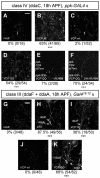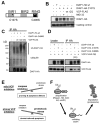Neuronal remodeling and apoptosis require VCP-dependent degradation of the apoptosis inhibitor DIAP1
- PMID: 21343367
- PMCID: PMC3042870
- DOI: 10.1242/dev.062703
Neuronal remodeling and apoptosis require VCP-dependent degradation of the apoptosis inhibitor DIAP1
Abstract
The regulated degeneration of axons or dendrites (pruning) and neuronal apoptosis are widely used during development to determine the specificity of neuronal connections. Pruning and apoptosis often share similar mechanisms; for example, developmental dendrite pruning of Drosophila class IV dendritic arborization (da) neurons is induced by local caspase activation triggered by ubiquitin-mediated degradation of the caspase inhibitor DIAP1. Here, we examined the function of Valosin-containing protein (VCP), a ubiquitin-selective AAA chaperone involved in endoplasmic reticulum-associated degradation, autophagy and neurodegenerative disease, in Drosophila da neurons. Strong VCP inhibition is cell lethal, but milder inhibition interferes with dendrite pruning and developmental apoptosis. These defects are associated with impaired caspase activation and high DIAP1 levels. In cultured cells, VCP binds to DIAP1 in a ubiquitin- and BIR domain-dependent manner and facilitates its degradation. Our results establish a new link between ubiquitin, dendrite pruning and the apoptosis machinery.
Figures







Similar articles
-
Drosophila Valosin-Containing Protein is required for dendrite pruning through a regulatory role in mRNA metabolism.Proc Natl Acad Sci U S A. 2014 May 20;111(20):7331-6. doi: 10.1073/pnas.1406898111. Epub 2014 May 5. Proc Natl Acad Sci U S A. 2014. PMID: 24799714 Free PMC article.
-
The spliceosome-associated protein Mfap1 binds to VCP in Drosophila.PLoS One. 2017 Aug 24;12(8):e0183733. doi: 10.1371/journal.pone.0183733. eCollection 2017. PLoS One. 2017. PMID: 28837687 Free PMC article.
-
Pathogenic Mutations in the Valosin-containing Protein/p97(VCP) N-domain Inhibit the SUMOylation of VCP and Lead to Impaired Stress Response.J Biol Chem. 2016 Jul 1;291(27):14373-14384. doi: 10.1074/jbc.M116.729343. Epub 2016 May 13. J Biol Chem. 2016. PMID: 27226613 Free PMC article.
-
Emerging functions of the VCP/p97 AAA-ATPase in the ubiquitin system.Nat Cell Biol. 2012 Feb 2;14(2):117-23. doi: 10.1038/ncb2407. Nat Cell Biol. 2012. PMID: 22298039 Review.
-
Mechanisms of Cdc48/VCP-mediated cell death: from yeast apoptosis to human disease.Biochim Biophys Acta. 2008 Jul;1783(7):1418-35. doi: 10.1016/j.bbamcr.2008.01.015. Epub 2008 Feb 2. Biochim Biophys Acta. 2008. PMID: 18284922 Review.
Cited by
-
Image-based screening identifies novel roles for IkappaB kinase and glycogen synthase kinase 3 in axonal degeneration.J Biol Chem. 2011 Aug 12;286(32):28011-8. doi: 10.1074/jbc.M111.250472. Epub 2011 Jun 17. J Biol Chem. 2011. PMID: 21685387 Free PMC article.
-
Common and Divergent Mechanisms in Developmental Neuronal Remodeling and Dying Back Neurodegeneration.Curr Biol. 2016 Jul 11;26(13):R628-R639. doi: 10.1016/j.cub.2016.05.025. Curr Biol. 2016. PMID: 27404258 Free PMC article. Review.
-
Valosin-containing protein and neurofibromin interact to regulate dendritic spine density.J Clin Invest. 2011 Dec;121(12):4820-37. doi: 10.1172/JCI45677. Epub 2011 Nov 21. J Clin Invest. 2011. PMID: 22105171 Free PMC article.
-
Visualizing and Measuring Dendrite Arborization in Drosophila Somatosensory Neurons.Methods Mol Biol. 2024;2831:59-71. doi: 10.1007/978-1-0716-3969-6_5. Methods Mol Biol. 2024. PMID: 39134843
-
Drosophila Valosin-Containing Protein is required for dendrite pruning through a regulatory role in mRNA metabolism.Proc Natl Acad Sci U S A. 2014 May 20;111(20):7331-6. doi: 10.1073/pnas.1406898111. Epub 2014 May 5. Proc Natl Acad Sci U S A. 2014. PMID: 24799714 Free PMC article.
References
-
- Beskow A., Grimberg K. B., Bott L. C., Salomons F. A., Dantuma N. P., Young P. (2009). A conserved unfoldase activity for the p97 AAA-ATPase in proteasomal degradation. J. Mol. Biol. 394, 732-746 - PubMed
-
- Brand A. H., Perrimon N. (1993). Targeted gene expression as a means of altering cell fates and generating dominant phenotypes. Development 118, 401-415 - PubMed
-
- Dietzl G., Chen D., Schnorrer F., Su K. C., Barinova Y., Fellner M., Gasser B., Kinsey K., Oppel S., Scheiblauer S., et al. (2007). A genome-wide transgenic RNAi library for conditional gene inactivation in Drosophila. Nature 448, 151-156 - PubMed
-
- Ditzel M., Wilson R., Tenev T., Zachariou A., Paul A., Deas E., Meier P. (2003). Degradation of DIAP1 by the N-end rule pathway is essential for regulating apoptosis. Nat. Cell Biol. 5, 467-473 - PubMed
-
- Dutta D., Bloor J. W., Ruiz-Gomez M., VijayRaghavan K., Kiehart D. P. (2002). Real-time imaging of morphogenetic movements in Drosophila using Gal4-UAS-driven expression of GFP fused to the actin-binding domain of moesin. Genesis 34, 146-151 - PubMed
Publication types
MeSH terms
Substances
Grants and funding
LinkOut - more resources
Full Text Sources
Molecular Biology Databases
Miscellaneous

